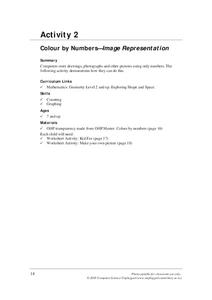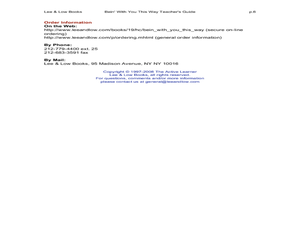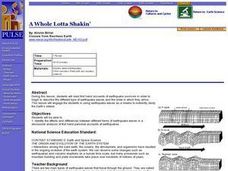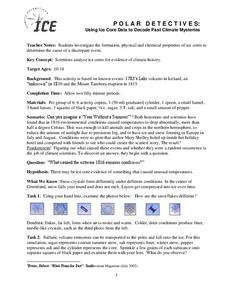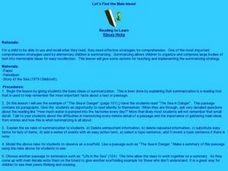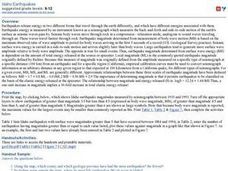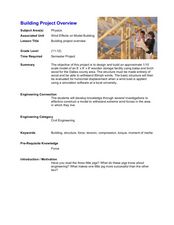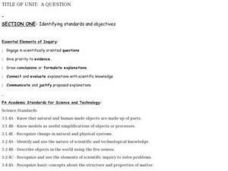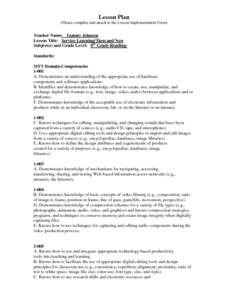Computer Science Unplugged
Colour by Numbers–Image Representation
How do computers store and send images? Here's an activity that explains one way a computer can compress image information. Pupils decode run-length coding to produce a black and white image. Pairs then work together to code and...
Teach Engineering
Bridging the Gaps
The London Bridge should not have fallen down. And here's why. After a brief history of bridges and the three main types, class members are introduce to the concepts of tension and compression, the two main forces acting upon bridges.
Curated OER
Bridge Building lab
Students investigate the 4 types of bridges and their strengths and weaknesses at an Internet Website. They describe one type of bridge that they have seen. Students pair off and face each other with their palms touching and feet flat...
Curated OER
The Formation of Coal
In this coal formation worksheet, students read and informational sheet about coal formation. Students are given 5 short-answer questions regarding what they've read.
Science Matters
Fault Formations
The San Andreas Fault moves about two inches a year, approximately the same rate fingernails grow—crazy! The third instructional activity in the series allows for hands-on exploration of various fault formations. Through the use of a...
Curated OER
Bein' With You This Way
Students complete pre reading, writing, during reading, and interdisciplinary activities for the book Bein' With You This Way. In this reading lesson plan, students complete journal entries, answer short answer questions, have...
Rutgers University
African-Americans in WWII
Using transcripts of interviews of African-Americans who served in WWII, class members work in pairs to understand their experience. Prior to the group work, the teacher provides background on WWII and the African-American experience....
Curated OER
A Whole Lotta Shakin'
Students read first hand accounts of earthquake survivors in order to begin the describe the different types of earthquake waves and the order in which they arrive. They engage in using earthquake waves as a means to indirectly study the...
Polar Trec
Polar Detectives: Using Ice Core Data to Decode Past Climate Mysteries
How does examining an ice core tell us about weather? Learners set up and explore fake ice cores made of sugar, salt, and ash to represent historical snowfall and volcanic eruptions. From their setups, scholars determine what caused the...
Curated OER
Science: Avalanche!
Eighth graders examine avalanches after reading excerpts from John Muir's book, "The Yosemite." In small groups, they conduct experiments with flour, sugar, and potato flakes representing different snow consistencies. Then, 8th graders...
Curated OER
Let's Find the Main Ideas!
Third graders examine how finding the main ideas and summarizing increases their reading comprehension. They read "The Sea in Danger" while applying the six rules of summarization in a modeled lesson. Next, working in small groups, they...
Curated OER
Locate-a-quake
Student, use seismic readings of the same earthquake from three recording stations and locate the epicenter of an earthquake on a map.
Curated OER
Idaho Earthquakes
Students examine the types of earthquakes that occur in Idaho. In groups, they compare and contrast the types of energy released and how they affect the movement of the Earth. To end the lesson, they analyze a map showing the magnitudes...
Curated OER
Understanding Computer Images
Ninth graders explain differences between bitmapped images and vector images. They calculate pixels and transpose the raw file size to bits, bytes, and kilobytes. They compare formats for displaying images on a Web page.
Curated OER
Media File Types
Students read about several different media file formats and determine which one is best used in specific situations. They go to different sites and read about the different media formats. Students then answer the questions that are...
Curated OER
Wind Effects on Model Building: Building Project Overview
Young scholars design their own building according to certain criteria. In this semester long physics activity, students calculate forces, compression and tension. They present their finished model in class.
Curated OER
Origin of Coal
Students explore how coal is formed. They then discuss the information and answer any questions that they may have on the formation of coal. Students then answer questions in reference to the coal discussion and reading.
Curated OER
Chocolate Chip Cookie Mining
To understand the impact coal mining has on the environment, pupils will extract chocolate chips from a cookie. Imagine the cookie is the environment and the chips are the coal. Instruct them to mine as many chips as they can, then have...
Curated OER
It's a Gas - Natural Gas
Students use plastic bottles, water, and condiment packets to simulate how natural gas comes from decaying ocean plants and animals. In this natural gas lesson plan, students also fill out lab packets and answer exit questions.
Curated OER
Sound Energy
Sixth graders understand properties and behavior of heat, light, and sound. They describe the production of sound in terms of vibration of objects that create vibrations in other materials. Students describe how sound is made from...
Curated OER
Electromagnets- 6 Mini Investigations
Third graders discover the properties of electromagnets through experiments. In this electromagnet properties lesson, 3rd graders complete six tasks with an elctromagnet. Students recognize that the wires will heat up when...
Curated OER
Engine Types
Students identify various types of engines and how they are different. In this engine lesson students view different types of engines using the Internet, take a quiz and type a quick write activity.
Curated OER
A QUESTION
Young scholars engage in scientifically oriented questions. They give priority to evidence, draw conclusions/formulate explanations and connect/evaluate explanations with scientific knowledge. Students communicate and justify proposed...
Curated OER
Service Learning/Then and Now
Eighth graders explore service learning projects. They work, in groups, to choose a video project. Students collect information and present it in a storyboard. Next, they use music, video clips, and still pictures to create their video...
